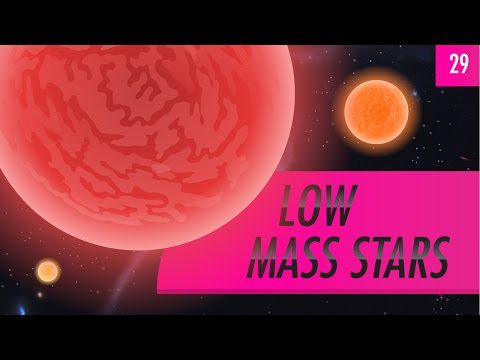Astăzi vorbim despre viața — și moartea — a stelelor. Stelele cu masă mică trăiesc mult timp, contopindu-și tot hidrogenul în heliu timp de un trilion de ani. Stele mai masive precum Soarele trăiesc o viață mai scurtă. Ele fuzionează hidrogenul în heliu și, în cele din urmă, heliul în carbon (și, de asemenea, puțin oxigen și neon). Când se întâmplă acest lucru, ele se extind, devin mai strălucitoare și se răcoresc, devenind giganți roșii. Ei își pierd cea mai mare parte din masă, expunându-și nucleele și apoi se răcesc pe parcursul a mai multor miliarde de ani.
Consultați posterul despre sistemul solar Crash Course Astronomy aici: http://store.dftba.com/products/crashcourse-astronomy-poster
—
capitole:
Introducere: Stele Low Mass 00:00
Fuziune de hidrogen 1:21
Ciclul de viață al stelelor cu masă scăzută 2:22
Stele mai mari (ca soarele nostru) trăiesc vieți mai scurte 3:10
Alimentat de Fusion 3:58
Giganții Roșii 5:45
Pitici albi 8:08
Soarta Pământului 8:59
Revizuire 11:07
—
PBS Digital Studios: http://youtube.com/pbsdigitalstudios
Urmărește-l pe Phil pe Twitter: https://twitter.com/badastronomer
Doriți să găsiți Crash Course în altă parte pe internet?
Facebook – http://www.facebook.com/YouTubeCrashCourse
Twitter – http://www.twitter.com/TheCrashCourse
Tumblr – http://thecrashcourse.tumblr.com
Asistență CrashCourse pe Patreon: http://www.patreon.com/crashcourse
—
FOTOGRAFII/VIDEOCLIPURI
Stele https://www.cursuriaz.ro/wp-content/uploads/localimages/n6522_32in.jpg [credit: Adam Block/Mount Lemmon SkyCenter/University of Arizona]
Dimensiunile stelelor http://www.eso.org/public/usa/images/eso1030c/ [credit: ESO/M. Kornmesser]
Fuziune în Soare https://commons.wikimedia.org/wiki/File:FusionintheSun.svg [credit: Borb, Wikimedia Commons]
Mega Flares https://www.cursuriaz.ro/wp-content/uploads/localimages/Swift-Mission-Observes-Mega-Flares-from-a-Mini-Star.jpg [credit: NASA’s Goddard Space Flight Center/S. Wiessinger]
Lângă Centauri https://www.spacetelescope.org/images/potw1343a/ [credit: ESA/Hubble & NASA]
Fizica în miez https://www.cursuriaz.ro/wp-content/uploads/localimages/cutaway.jpg [credit: NASA / Marshall Space Flight Center]
Trei ani de imagini SDO http://svs.gsfc.nasa.gov/cgi-bin/details.cgi?aid=11255 [credit: NASA’s Goddard Space Flight Center/SDO]
Soare și Giganți Roșii http://kepler.nasa.gov/files/mws/kasc3.jpg [credit: NASA]
Soarele ca Gigantul Roșu https://commons.wikimedia.org/wiki/File:Sun_red_giant.svg [credit:Oona Räisänen, Wikimedia Commons]
Pe aripile vantului https://www.eso.org/public/usa/images/wr124/ [credit: ESO]
Extindere și răcire https://www.cursuriaz.ro/wp-content/uploads/localimages/base.jpg [credit: ESO/L. Calçada]
Privind în jos un butoi de gaz la o stea condamnată http://hubblesite.org/newscenter/archive/releases/1999/01/image/a/ [credit: The Hubble Heritage Team (AURA/STScI/NASA)]
Orbită stele în expansiune https://www.cursuriaz.ro/wp-content/uploads/localimages/415775main_earthlike-exoplanet-full.jpg [credit: SO/L. Calçada]
Pământul Gigant Roșu https://www.cursuriaz.ro/wp-content/uploads/localimages/a-3ERed_Giant_Earth.jpg [credit: Fsgregs, Wikimedia Commons]
Nebuloasa Crabului https://www.cursuriaz.ro/wp-content/uploads/localimages/a-3ECrab_Nebula.jpg6601700a13f5a.jpg [credit: NASA, ESA, J. Hester and A. Loll (Arizona State University)]
Cursuri interesante:
- Observații cu ochiul liber: Astronomie de curs accidental #2
- Stars: Crash Course Astronomy #26
- Fazele Lunii: curs accidental Astronomie #4
- Lumină: Crash Course Astronomie #24
- Jupiter: Crash Course Astronomy #16
- Uranus și Neptun: Crash Course Astronomie #19
- The Sun: Crash Course Astronomie #10
- Telescoape: Crash Course Astronomy #6
- Introducere în astronomie: curs accidental de astronomie #1
- Lunii lui Jupiter: Astronomie de curs accidental #17

You're the best. I wish you had been my astronomy prof. I give you 5 stars to the 10th power 😉
Great stuff… It should make all of us humble… But I guess, looking around, that's not the case… Not enough people look up to the sky… Too bad…
Why do I feel like I still don't know anything about low-mass stars??? Could just be me and my sleep-deprived brain.
Episode 28: Brown Dwarfs
Episode 29: Low Mass Stars
i see a pattern here…
can low mass stars become high mass star? what if billions of planets get consumed by sun will it become high mass star?
It's absolutely incredible! I have never used this channel before. I am Physics student and this is sooo useful to understand the concepts of my Stellar Structure and Evolution course, so I can get the "intuition" and big picture, that is the most important thing in Physics! Thank you SOOO much =)
This guy is such a great teacher.
the emo guy at 00:26 pleasee